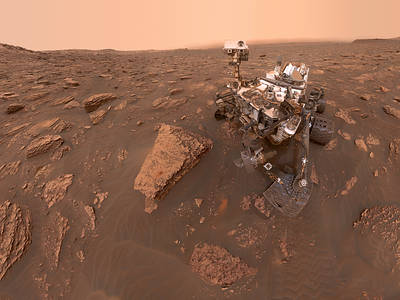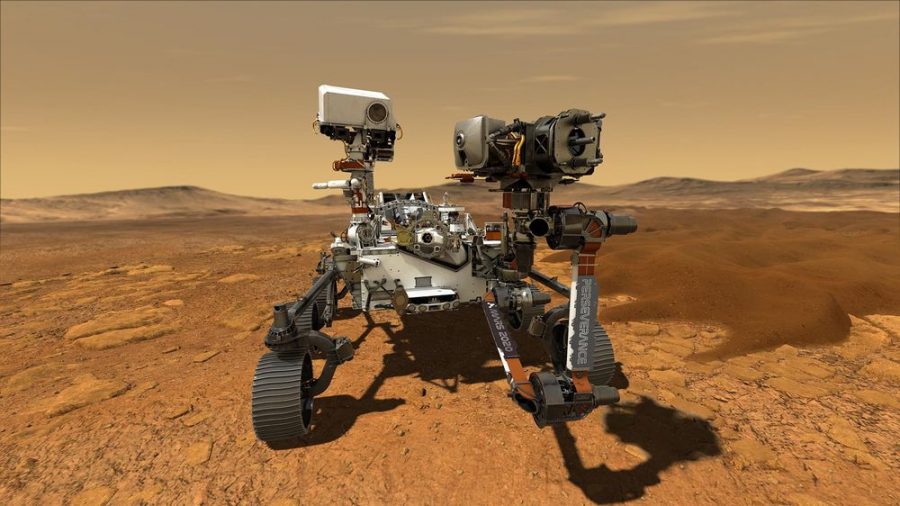Is there life on Mars? This is a question that humans have been asking for a long time. With the help of new technology and research, we have slowly been nearing the answer to this question. The latest Mars rover, Perseverance, is getting us closer than ever before to finding out if there really is, or ever was, life on the Red Planet. Dr. Melissa Rice, Associate Professor of Planetary Science at Western Washington University and a member of the Mastcam-Z instrument team, has answered many questions about the rover and its capabilities.
Rice answered one of the most common inquiries about the rover: what data is being collected and what will it be used for? “The rover is collecting a series of information with its cameras and spectrometers. It has a fully equipped set of instruments, but really what the rover is going to be collecting are physical rock samples and eventually, those rocks will be brought back to Earth and that’s where the real exciting work begins in Earth laboratories to look for evidence of ancient life that may be preserved in those rock samples,” Rice explained.
In 2012, the Curiosity rover landed on Mars. You may find yourself asking, “What’s the difference?” Perseverance has some significant differences and an entirely different mission. “Perseverance is really a big next leap beyond Curiosity. The two rovers, if you put them side by side, they may look like identical twins, but Perseverance really has a brand new set of instruments and a brand new mission on Mars. Curiosity was really a science laboratory meaning that Curiosity studied Mars rocks on Mars with a wet chemistry laboratory on the inside of the rover, but Perseverance has a much different mission,” Rice said. “Really, it’s about identifying the most interesting rocks and then collecting them in a very thorough way, storing them in sample tubes, hermetically sealing those tubes, and then leaving them on Mars’s surface so that the next mission can come, grab those rocks and bring them back to Earth. So it’s a much different mission requiring much different instruments and much different capabilities for this rover.”
This was a big project and took a long time and a lot of people to accomplish, but just how long and how many? “Thousands of people actually contributed to this over the past eight years. So it’s almost a decade of effort with people around the country and we have contributions from around the world as well, “Rice stated. “Just on the science team we have about 450 people who are just working on the science questions and will be analyzing the data, but there are engineering teams and contractors that NASA has hired to help us build every teeny tiny little aspect of this rover. From the motors that are in the cameras, to the tiny screws holding things together, it’s really an effort of several thousand people over the last 10 years.”
Ingenuity is Perseverance’s sidekick and the first powered craft of any kind to fly in the atmosphere of another planet. But what exactly is it and what is it testing? “This is something brand new and what’s going to happen is that right now, Perseverance has Ingenuity attached to its belly. I kind of think of Perseverance like the mama kangaroo and it has its baby tucked in its pouch and then, after it lands on Mars, after the first month of the mission, once we know everything is okay with the rover, Perseverance is going to find a nice, safe spot to drop Ingenuity on the surface. So, it will drop the helicopter down on the surface, and then drive away a safe distance. So that when Ingenuity starts up its blades for the first time and starts to fly, we don’t have any risk of smacking into Perseverance. So, Ingenuity will have its own mission, about 30 days it will have. It will make at least five flights and Ingenuity has two cameras on board as well and so it will be able to look back and take pictures of Perseverance on the ground, I’m really excited to see those, and it’ll also be able to look up ahead, at the places that Perseverance might be driving to in the next months and years and get a good, aerial view of those landscapes that Perseverance can’t really see from the ground,” Rice said.
This mission will contribute not only to scientific research but also help set the stage for future human missions to Mars. How exactly will this pave the way for humans? “One of Perseverance’s actual science goals, is to prepare for humans on the surface of Mars and the way that Perseverance is going to do that, the way that Perseverance is going to make progress towards humans on the surface, is it’s going to carry an instrument that is a chemistry experiment that for the first time will take Martian atmosphere, air from Mars which is carbon dioxide and convert it in a little laboratory into breathable oxygen,” explained Rice. “That breathable oxygen, molecular O2, that is the same kind of oxygen that we can compress into a liquid and use for rocket fuel. So, the idea is that Perseverance is testing technology that might be used for future human missions. I can imagine an instrument like that going on a robotic spacecraft to Mars, sitting there and filling a bunch of empty air tanks so that when humans arrive, they have all their breathable air waiting for them on Mars and they have their rocket fuel for their return flight home sitting there, ready to go.”

All of this is nice, but how will it impact the lives of regular people? “I think that it’s going to brighten people’s days. NASA does a great job of making all of the data from missions publicly available almost immediately and so everyone will be able to see new photographs from the rover at the same time I do, as a person who works on the cameras and is part of the mission team,” Rice said. “You will be able to follow along this mission in real time and see the new images at the same time that the NASA scientists are seeing them for the first time, and I think that that is something that is really an endeavor that all of humanity is involved in. It’s really not just a group of scientists at NASA who are operating this rover, we are doing this on behalf of the entire country and the entire world and making what we learn available to everyone. So, I hope that people will be logging on to NASA’s website, looking at the new photographs and being part of this journey and right now is an especially good time to kind of get your mind away from Earth for a little bit and to think about the big questions that Perseverance is trying to answer. Are we alone in the universe and what is next for humanity? So, hopefully this mission will be a way to help people do that.”
As the rover collects more data, takes more photos, and uses all its instruments and technology, we will get closer to answering the big question: Is there life on Mars? Some time soon, we will finally find out.
A special thanks to Melissa Rice for her time and her excellent explanations and to Rani Gran for setting up the interview!







